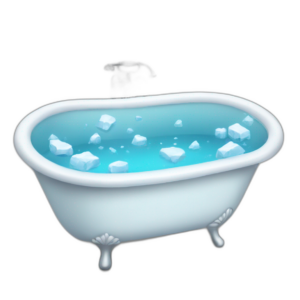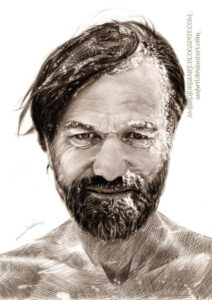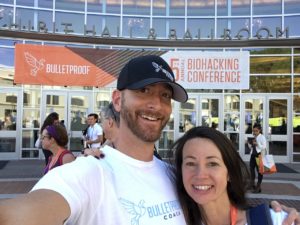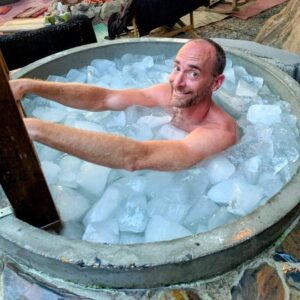Table of Contents
ToggleMy Icy Awakening (to incredible ice bath benefits)
Ten years ago, I stood shivering in front of my apartment’s ice machine, contemplating what seemed like a crazy idea: an ice bath.

Little did I know that this moment would mark the beginning of a transformative journey into the world of cold therapy.
As I filled my bathtub with a mix of cold water and ice, I had no clue about the science behind what I was about to do.

All I knew was that I was about to challenge myself in a way I never had before.
Lowering myself into that first ice bath was a shock to the system – both literally and figuratively.
The cold hit me like a freight train, stealing my breath and making every muscle in my body tense up.
But as I forced myself to breathe and relax, something unexpected happened:
I began to feel… alive.
After just a few minutes (which felt like an eternity), I emerged from the ice bath feeling invigorated, alert, and oddly energized.
This experience sparked a curiosity that would lead me down a path of exploration into the benefits of cold exposure.
The Science-Backed Benefits of Ice Baths
While my first ice bath was based on intuition and a desire for challenge, I’ve since learned that the benefits of cold therapy are well-supported by scientific research:
- Improved Circulation: Studies have shown that the alternating vasoconstriction and vasodilation caused by cold exposure can enhance overall cardiovascular health 1.
- Reduced Inflammation: Research indicates that ice baths can significantly decrease inflammation markers in the body, potentially aiding in recovery from exercise and reducing chronic inflammation 2.
- Enhanced Immune Function: The Wim Hof Method *, which incorporates cold exposure, has been scientifically proven to boost the immune system 3.
- Increased Metabolism: Cold exposure activates brown adipose tissue, potentially aiding in weight management and metabolic health 4.
- Mental Health Benefits: Cold therapy has been linked to improved mood, reduced symptoms of depression, and increased mental resilience 5.
These benefits aren’t just theoretical – they’re effects I’ve personally experienced over years of consistent cold exposure practice.
From quicker recovery after workouts to a noticeable improvement in my overall mood and stress resilience, ice baths have become an integral part of my wellness routine.

“The cold is your warm friend.”
Initially, this statement seemed paradoxical to me, but now I understand its profound truth.
The discomfort of the cold pushes you to find warmth within yourself, both literally and metaphorically.
In the next section, I’ll share more about my personal journey with cold therapy and how it has evolved over the years.
References
Cardiovascular and metabolic responses to passive hypoxic conditioning in overweight and mildly obese individuals ↩
Cold water immersion and recovery from strenuous exercise: a meta-analysis ↩
Voluntary activation of the sympathetic nervous system and attenuation of the innate immune response in humans ↩
Brown Adipose Tissue: Function and Physiological Significance ↩
Cold adaptation and cognitive performance: Evidence for a shift in the thermal comfort zone ↩
My Cold Therapy Journey: From Novice to Zen Strength Practitioner
After my initial ice bath experience, I became intrigued by the potential of cold exposure.
My journey took an exciting turn in 2015 when I attended the Bulletproof Biohacking Conference and had the opportunity to see Wim Hof in person. *

Wim’s enthusiasm and the scientific backing behind his method ignited a deeper interest in me to explore cold therapy further. *
As I pursued my certification as a Bulletproof Human Potential Coach, I began to integrate cold exposure more consistently into my daily routine.
My Cold Exposure Progression:
- Cold Showers: I started with ending my regular showers with 30 seconds of cold water, gradually increasing the duration.
- Outdoor Cold Exposure: Living in Colorado, Los Angeles and now Chiang Mai, I’ve sought out opportunities to expose myself to colder temperatures.
- Natural Cold Water Immersion: I began seeking out cold mountain lakes, streams, and ocean dips during my travels.
- Consistent Ice Baths: Eventually, I incorporated regular ice baths into my routine, using proper techniques and breathing methods.

This gradual progression allowed my body to adapt and helped me build mental resilience.
Dr. Rhonda Patrick, a renowned biomedical scientist, explains the importance of this gradual approach:
“Cold stress, like exercise, is a hormetic stress – meaning that it can be beneficial in the right dose.” 1
As I continued my practice, I noticed several changes:
- Increased energy levels throughout the day
- Improved mood and mental clarity
- Enhanced recovery after workouts
- Better stress management in daily life
Interestingly, the immediate “high” I used to feel after an ice bath has somewhat diminished over time.
However, I’ve noticed that my baseline energy, mood, and motivation have significantly improved.
This aligns with research suggesting that regular cold exposure can lead to long-term adaptations in the body’s stress response systems 2.
My experiences eventually led me to develop my own approach to cold therapy, which I now share through Zen Strength workshops and coaching.
By integrating the physiological benefits of cold exposure with mindfulness techniques, I’ve found a powerful tool for overall health and personal growth.
As Andrew Huberman, neuroscientist and cold therapy advocate, states:
“Cold exposure is one of the rare tools we have to create a deliberate stress, which then allows the body to adapt and get stronger.” 3
In the next section, we’ll delve deeper into the science behind these benefits and explore how you can safely incorporate cold therapy into your own routine.
References
The Science Behind Ice Bath Benefits: More Than Just a Cool Experience
As my journey with cold therapy progressed, I became fascinated by the science behind its numerous benefits.
Let’s dive into the research that explains why ice baths are more than just a test of willpower.
1. Improved Circulation
Cold exposure causes vasoconstriction (narrowing of blood vessels) followed by vasodilation (widening of blood vessels) as the body warms up.
This process, similar to a cardiovascular workout, can improve overall circulation over time 1.
A study in the Journal of Science and Medicine in Sport found that cold water immersion can enhance blood flow and reduce muscle soreness after exercise 2.
2. Enhanced Recovery and Reduced Inflammation
One of the most well-known benefits of ice baths is their ability to aid in post-exercise recovery.
A meta-analysis published in the British Journal of Sports Medicine showed that cold water immersion significantly reduced muscle soreness after exercise 3.
The cold exposure reduces inflammation by decreasing the production of inflammatory cytokines and increasing anti-inflammatory cytokines 4.
3. Boosted Immune System
The Wim Hof Method, which combines cold exposure with breathing techniques, has been scientifically proven to boost the immune system. *
A groundbreaking study published in PNAS showed that participants trained in the Wim Hof Method could voluntarily influence their autonomic nervous system and immune response 5. *
As someone who regularly practices cold exposure, I’ve noticed I get sick less often and recover more quickly when I do catch a bug.
4. Metabolic Benefits
Cold exposure activates brown adipose tissue (BAT), also known as “good fat,” which burns calories to generate heat.
A study in the Journal of Clinical Investigation found that cold exposure can increase BAT activity and energy expenditure 6.
This metabolic boost can potentially aid in weight management and overall metabolic health.
5. Mental Health and Cognitive Benefits
Perhaps the most surprising benefits I’ve experienced from ice baths are the improvements in my mental health and cognitive function.
Research published in Medical Hypotheses suggests that cold exposure can have antidepressive effects by stimulating the production of norepinephrine in the brain 7.
A study in the journal PLOS One found that regular winter swimming was associated with better memory function and mood 8.
I can attest to this – after an ice bath, I often feel a sense of mental clarity and focus that lasts for hours.
6. Hormetic Stress and Resilience
Ice baths are a form of hormetic stress – a beneficial type of stress that strengthens the body’s resilience.
Dr. Rhonda Patrick explains:
“Exposure to cold is a type of hormetic stress, which can activate genetic pathways that promote longevity and healthspan.” 9
This concept of hormesis aligns with my personal experience – the discomfort of the ice bath has made me more resilient to other forms of stress in daily life.
7. Sleep Improvement
While not often discussed, I’ve found that regular cold exposure has improved my sleep quality.
A study in Sleep Medicine Reviews suggests that body cooling can improve sleep onset and quality 10.
I often find that on days when I take an ice bath, I fall asleep more easily and wake up feeling more refreshed.
Understanding the science behind these benefits has only deepened my appreciation for cold therapy.
It’s not just about enduring discomfort – it’s about providing our bodies with a stimulus that triggers a cascade of beneficial physiological responses.
In the next section, I’ll share some practical tips on how you can safely incorporate ice baths into your own routine and start experiencing these benefits for yourself.
References
The effect of post-exercise cryotherapy on recovery characteristics: a systematic review and meta-analysis ↩
Effect of water immersion methods on post-exercise recovery from simulated team sport exercise ↩
Cold water immersion and recovery from strenuous exercise: a meta-analysis ↩
Whole-body cryotherapy: empirical evidence and theoretical perspectives ↩
Voluntary activation of the sympathetic nervous system and attenuation of the innate immune response in humans ↩
Adapted cold shower as a potential treatment for depression ↩
Effects of thermal environment on sleep and circadian rhythm ↩
Getting Started with Ice Baths: My Practical Guide
After years of experience and guiding others through cold therapy, I’ve developed a practical approach to help beginners safely start their ice bath journey.
Remember, everyone’s journey is unique, so listen to your body and progress at your own pace.
Safety First: Know the Risks
Before you start, it’s crucial to understand that ice baths aren’t for everyone.
Certain health conditions may make cold therapy dangerous, so always consult with a healthcare professional before starting 1.
Conditions that may contraindicate cold therapy include:
- Heart conditions
- High blood pressure
- Peripheral neuropathy
- Raynaud’s syndrome
- Pregnancy
The Gradual Progression Technique
- Start with Cold Showers
- Begin with 15-30 seconds of cold water at the end of your regular shower.
- Gradually increase the duration over time.
- Focus on controlled breathing during the cold exposure.
- Progress to Contrast Showers
- Alternate between hot and cold water.
- Start with 1 minute hot, 15 seconds cold.
- Gradually increase the cold duration and decrease the hot.
- Move to Cold Immersion
- Fill a bathtub with cold tap water (no ice yet).
- Aim for 2-3 minutes of immersion.
- Focus on keeping your breathing slow and controlled.
- Introduce Ice Baths
- Start with water around 15°C (59°F) and gradually decrease the temperature over time.
- Begin with 2-3 minute sessions and slowly increase duration.
- Never exceed 15 minutes in an ice bath.
Proper Ice Bath Technique
When you’re ready for a full ice bath, follow these steps:
- Prepare the Bath: Fill your tub with cold water and add ice to reach 10-15°C (50-59°F).
- Mental Preparation: Take a few deep breaths and set an intention for your practice.
- Gradual Entry: Enter the water slowly, allowing your body to adjust.
- Breathing: Focus on slow, deep breaths to help manage the cold shock response.
- Duration: Start with 2-3 minutes and gradually increase over time, not exceeding 15 minutes.
- Exit Slowly: After your session, exit the bath carefully as your muscles may be cold.
- Warm Up Naturally: Allow your body to warm up on its own rather than using hot showers or saunas immediately after.
Breathing Techniques for Cold Immersion
Proper breathing is crucial for managing the cold shock response and maximizing benefits.
I often use and teach the following Coherent Breathing technique:
- Take a slow, expansive breath in through your nose for 5 seconds.
- Exhale slowly through your nose for 5 seconds.
- Repeat this cycle throughout your ice bath session.
This controlled Coherent breathing helps activate the parasympathetic nervous system, reducing stress and allowing you to stay in the cold water longer 2.
My Personal Tips
- Consistency is Key: Regular practice, even with shorter durations, is more beneficial than infrequent longer sessions.
- Mind Over Matter: Much of cold therapy is mental.
“The cold is your warm friend and teacher.”
Embrace the discomfort as a path to growth.
- Track Your Progress: Keep a journal of your cold therapy sessions, noting duration, temperature, and how you feel before and after.
- Hydrate Well: Drink plenty of water before and after your ice bath to support your body’s thermoregulation.
- Listen to Your Body: If something doesn’t feel right, stop. It’s okay to progress slowly.
Remember, the goal isn’t to endure extreme discomfort, but to challenge yourself in a controlled, beneficial way.
As you progress in your practice, you’ll likely find, as I have, that the benefits extend far beyond the physical – influencing your mental resilience, emotional well-being, and overall approach to life’s challenges.
In the next section, we’ll explore how to integrate cold therapy into your lifestyle for long-term benefits and overall wellness optimization.
References
Long-Term Benefits and Lifestyle Integration: My Zen Strength Approach
As you progress in your cold therapy journey, you’ll likely notice that the benefits extend far beyond the immediate post-ice bath high.
In my experience, consistent practice leads to profound long-term changes in both body and mind.
Let’s explore how to integrate cold therapy into your lifestyle for optimal benefits and overall wellness.
Increased Cold Tolerance
One of the most noticeable long-term effects is an increased tolerance to cold temperatures.
This adaptation isn’t just about comfort; it’s a sign of improved metabolic health and brown fat activation 1.
I’ve found that as my cold tolerance increased, I needed less heavy clothing in winter and felt more comfortable in a wider range of temperatures.
Elevated Baseline Energy and Mood
While the initial “high” from ice baths may diminish over time, I’ve experienced a significant increase in my baseline energy and mood.
Research suggests that regular cold exposure can lead to long-term changes in neurotransmitter levels, potentially improving mood and reducing symptoms of depression 2.
I’ve noticed a consistent sense of alertness and positivity throughout my day, which I attribute in part to my cold therapy practice.
Enhanced Stress Resilience
Cold exposure is a form of hormetic stress, which can strengthen your overall stress response system.
A study in the journal PLOS One found that regular winter swimmers reported less stress and fatigue and more vigor than control groups 3.
In my personal and professional life, I’ve found myself better equipped to handle stressful situations with calm and clarity.
Potential Long-Term Health Improvements
Emerging research suggests that regular cold exposure may have long-term health benefits, including:
While more research is needed, these potential benefits align with my experience of improved overall health and fewer illnesses since starting my cold therapy practice.
The Zen Strength Approach: Integrating Cold Therapy into Daily Life
To truly reap the long-term benefits of cold therapy, it’s essential to integrate it into your lifestyle in a sustainable way.
Here’s my Zen Strength approach to making cold therapy a consistent part of your wellness routine:
- Start Your Day Cold: Begin with a brief cold shower in the morning to kickstart your metabolism and boost alertness.
- Use Nature’s Cold Therapy: Take advantage of cold weather for outdoor exercises or walks, embracing the natural cold exposure.
- Incorporate Breathwork: Combine cold exposure with controlled breathing techniques to enhance the mental and physical benefits.
- Practice Mindfulness: Use your cold therapy sessions as an opportunity for mindfulness practice, focusing on your breath and bodily sensations.
- Gradual Progression: Continuously challenge yourself by gradually decreasing water temperature or increasing exposure time.
- Balance with Heat: Incorporate contrast therapy by alternating between cold exposure and heat (like saunas) for additional health benefits 7.
- Stay Consistent: Aim for regular cold exposure sessions, even if they’re short, rather than infrequent longer sessions.
My Personal Routine
My current routine involves two to five ice bath sessions per week (5-10 minutes at 5-10°C/50°F).
I lead group ice bath sessions in Chiang Mai, which not only helps others experience the benefits but also keeps me accountable to my practice.
As Dr. Susanna Søberg, author of “Winter Swimming,” notes:
“Regular exposure to cold is like a workout for your vascular system. It trains your blood vessels to constrict and dilate efficiently, which can have numerous health benefits.” 8
By integrating cold therapy into your daily life, you’re not just enduring discomfort; you’re training your body and mind to be more resilient, energetic, and balanced.
In the next section, we’ll explore how to combine cold therapy with other wellness practices for a holistic approach to health and performance optimization.
References
Brown adipose tissue activity after a high-calorie meal in humans ↩
Adapted cold shower as a potential treatment for depression ↩
Cardiovascular and hormonal responses to cold stress following repeated cold water immersion ↩
The effects of cold exposure on leukocytes, hormones and cytokines during acute exercise in humans ↩
Cold Shock Proteins: A Promising Therapeutic Target for Acute and Neurodegenerative Disorders ↩
Effects of far-infrared sauna bathing on recovery from strength and endurance training sessions in men ↩
The Zen Strength Holistic Approach: Combining Cold Therapy with Other Wellness Practices
Throughout my journey with cold therapy, I’ve discovered that its benefits are amplified when combined with other wellness practices.
This holistic approach forms the core of my Zen Strength philosophy, aiming to optimize overall health and performance.
Let’s explore how to integrate cold therapy with other practices for maximum benefit.
1. Breathwork and Cold Therapy: A Powerful Duo
Combining specific breathing techniques with cold exposure can enhance the benefits of both practices.
The Wim Hof Method, which I practiced daily during a 10-week course, is a prime example of this powerful combination 1. *
Here’s a simple breathwork routine I often use before and during cold exposure:
- Take 30-40 deep, rhythmic breaths
- On the last exhale, hold your breath for as long as comfortable
- Take a deep recovery breath and hold for 15 seconds
- Repeat this cycle 3-4 times
- Do coherent breathing (5s in; 5s out) before entering the cold water
This technique helps activate the parasympathetic nervous system, making the cold exposure more manageable and potentially more beneficial.
2. Mindfulness and Cold Immersion
Cold exposure provides an excellent opportunity to practice mindfulness and presence.
Research suggests that mindfulness can enhance the stress-reducing effects of cold therapy 2.
During your ice bath, try this mindfulness exercise:
- Focus on your breath
- Notice physical sensations without judgment
- Observe any thoughts or emotions that arise, letting them pass without attachment
This practice not only makes the cold more bearable but also trains your mind to stay calm in challenging situations.
3. Exercise and Cold Therapy: Optimizing Recovery
Integrating cold therapy into your exercise routine can significantly enhance recovery and performance.
A study in the Journal of Science and Medicine in Sport found that cold water immersion after exercise can improve recovery and subsequent performance 3.
My personal post-workout routine often includes a 5-minute ice bath, which I find reduces muscle soreness and improves recovery time.
4. Nutrition and Cold Exposure: Fueling for Thermogenesis
Proper nutrition can support your body’s response to cold exposure and enhance its benefits.
Foods rich in healthy fats and proteins can help fuel thermogenesis (heat production) during cold exposure 4.
Some of my go-to foods before cold therapy sessions include:
- Avocados
- Nuts and seeds
- Fatty fish
- Grass-fed meats
I also ensure I’m well-hydrated before any cold exposure session.
5. Sleep Optimization and Cold Therapy
Cold exposure, especially when done in the evening, can improve sleep quality by helping to lower core body temperature 5.
I often take a short cold shower about an hour before bed, which I find helps me fall asleep faster and sleep more deeply.
Combining this with good sleep hygiene practices, such as maintaining a consistent sleep schedule and avoiding blue light before bed, can significantly improve your overall sleep quality.
6. Sauna Use and Cold Therapy: The Power of Contrast
Alternating between heat exposure (sauna) and cold therapy can provide additional health benefits.
This practice, known as contrast therapy, has been shown to improve circulation, boost the immune system, and enhance recovery 6.
My typical contrast therapy session looks like this:
- 3 minutes in an ice bath
- 15 minutes in the sauna
- 1 minute in an ice bath
I find this practice incredibly invigorating and often feel a profound sense of relaxation and clarity afterwards.
7. Meditation and Cold Exposure: Training the Mind
Regular meditation practice can enhance your ability to remain calm during cold exposure.
Conversely, the focus required during cold immersion can improve your meditation practice.
I often incorporate a short meditation session immediately after my ice baths, finding that my mind is particularly clear and focused at this time.
The Zen Strength Workshop Experience
In my Zen Strength workshops, I guide participants through a combination of these practices:
- Breathwork exercises
- Guided ice bath sessions
- Mindfulness techniques
- Post-cold exposure meditation
This holistic approach allows participants to experience the synergistic benefits of these combined practices.
As Dr. Rhonda Patrick notes,
“The combination of various hormetic stressors like exercise, heat exposure, cold exposure, and fasting, when applied judiciously, can lead to a more robust stress response system and improved overall health.” 7
By integrating cold therapy with these complementary practices, you’re not just improving your cold tolerance – you’re optimizing your overall health, resilience, and performance.
In our final section, we’ll recap the key benefits of ice baths and cold therapy, and I’ll share some final thoughts on how to make this practice a sustainable part of your wellness journey.
References
Voluntary activation of the sympathetic nervous system and attenuation of the innate immune response in humans ↩
Mindfulness-based stress reduction and physiological activity during acute stress: A randomized controlled trial ↩
Effect of water immersion methods on post-exercise recovery from simulated team sport exercise ↩
Brown adipose tissue: function and physiological significance ↩
Effects of thermal environment on sleep and circadian rhythm ↩
Effects of contrast water therapy on recovery from exercise-induced muscle damage ↩
Conclusion: Embracing the Cold for a Warmer Life
As we wrap up this deep dive into the world of ice baths and cold therapy, let’s recap the key benefits and takeaways from my personal journey and the scientific research.
Key Benefits of Ice Baths and Cold Therapy
- Improved Circulation: Regular cold exposure can enhance cardiovascular health and blood flow 1.
- Reduced Inflammation: Ice baths can significantly decrease inflammation markers, aiding in recovery and overall health 2.
- Enhanced Immune Function: Cold therapy has been shown to boost the immune system, potentially reducing the frequency of illnesses 3.
- Increased Metabolism: Cold exposure activates brown adipose tissue, potentially aiding in weight management 4.
- Mental Health Benefits: Cold therapy can improve mood, reduce symptoms of depression, and increase mental resilience 5.
- Better Sleep Quality: Evening cold exposure can help lower core body temperature, promoting better sleep 6.
- Hormetic Stress and Resilience: Regular cold exposure builds overall stress resilience, preparing you for life’s challenges 7.
My Personal Transformation
Reflecting on my decade-long journey with cold therapy, I’m amazed at the profound impact it has had on my life.
From that first hesitant ice bath in my apartment to now leading Zen Strength workshops, cold therapy has been a transformative practice for me.
I’ve experienced increased energy levels, improved mood, enhanced recovery from workouts, and a greater sense of overall wellbeing.
Perhaps most importantly, cold therapy has taught me the power of embracing discomfort for growth – a lesson that extends far beyond the ice bath.
Making Cold Therapy a Sustainable Practice
The key to reaping the long-term benefits of cold therapy lies in consistency and gradual progression.
Start small with cold showers, and slowly work your way up to longer exposures and colder temperatures.
Remember, it’s not about enduring extreme discomfort, but about challenging yourself in a controlled, beneficial way.
Integrate cold therapy with other wellness practices like breathwork, meditation, and exercise for a holistic approach to health optimization.
A Final Thought
“The cold is merciless, but it’s also righteous.” 8
This quote resonates deeply with me because it encapsulates the dual nature of cold therapy – it’s challenging, yes, but it’s also incredibly rewarding.
The cold doesn’t discriminate; it simply reflects back what’s inside you.
Through consistent practice, you’ll likely find, as I have, that there’s much more strength, resilience, and capability within you than you ever realized.
Invitation to Experience Cold Therapy
If you’re intrigued by the benefits of cold therapy and want to experience it for yourself, I invite you to join one of my Zen Strength workshops in Chiang Mai.
In these sessions, we combine breathwork, cold exposure, and mindfulness techniques to create a truly transformative experience.
For those not in Chiang Mai, remember that your cold therapy journey can start right at home with a simple cold shower.
The path of cold therapy is one of continuous learning, growth, and self-discovery.
As you embark on or continue your own cold therapy journey, remember to listen to your body, progress gradually, and most importantly, enjoy the process.
The cold is indeed your warm friend and teacher – embrace it, and watch as it unlocks new levels of health, resilience, and vitality in your life.
References
The effect of cold showering on health and work: A randomized controlled trial ↩
Whole-body cryotherapy: empirical evidence and theoretical perspectives ↩
Voluntary activation of the sympathetic nervous system and attenuation of the innate immune response in humans ↩
Adapted cold shower as a potential treatment for depression ↩
Effects of thermal environment on sleep and circadian rhythm ↩
* Not affiliated with the Wim Hof Method.
With Jason as your certified Human Potential Coach, you’ll go beyond the Wim Hof Method — optimizing energy, sleep, and performance.
